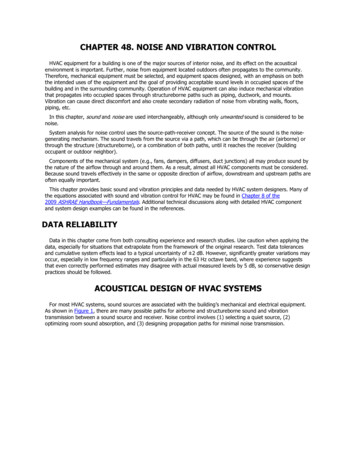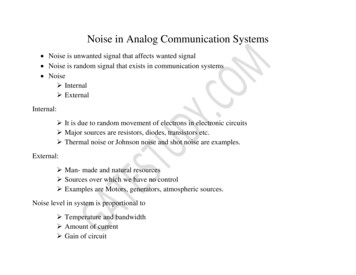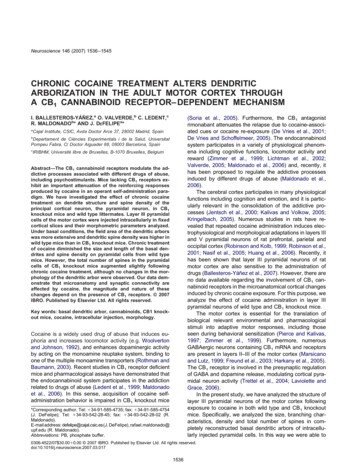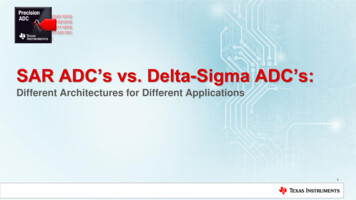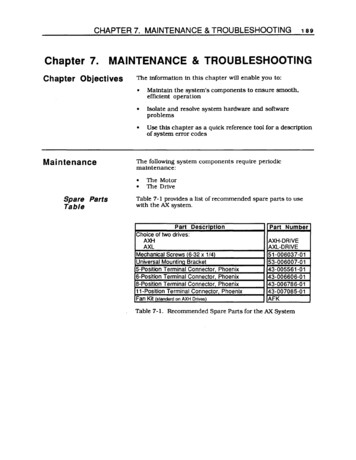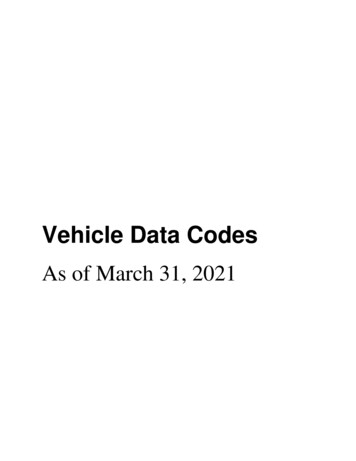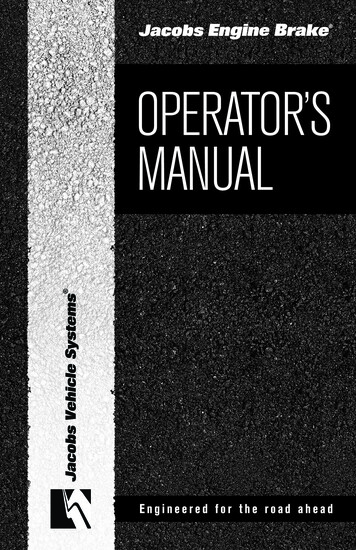
Transcription
PROCEEDINGS of the Eighth International Driving Symposium on Human Factors in Driver Assessment, Training and Vehicle DesignIN-VEHICLE NOISE ALTERS THE PERCEIVED MEANING OF AUDITORY SIGNALSNeil Lerner1, Jeremiah Singer1, Daniel Kellman1, & Eric Traube21Westat, Rockville, Maryland, USA2National Highway Traffic Safety Administration, Washington, DC, USAEmail: neillerner@westat.comSummary: Research on driver perception and interpretation of auditory signalshas generally been conducted under conditions of low-to-moderate ambient in-cabnoise. In a series of four experiments, the effects of various ambient noiseconditions on the perceived meaning of auditory signals were investigated. Noiseconditions that may be realistically anticipated in the course of normal drivingaltered the perceived urgency and meaning of signals. The presence and extent ofsuch changes was a function of the specific auditory signal, the ambient noisecondition, and their interaction. The results indicate that in-vehicle auditory signaldesign criteria developed only under low-to-moderate ambient noise conditionsare not likely to be sufficient. The significant signal-by-ambient noise interactionfurther suggests that multiple noise backgrounds must be considered.OBJECTIVESAuditory signals are a primary means of warning drivers about high-urgency potential crashsituations to which the driver must react quickly. Auditory signals may also be used to informthe driver about a variety of other situations, such as less urgent safety considerations, trafficinformation, vehicle status, or notification of incoming communications. As auditory signalsbecome more prevalent during driving, it is essential that critical crash warnings be clearlydiscriminable from other sorts of messages. For an in-vehicle system of warnings, alerts, andnotifications to be effective, signals for each type of message should convey their appropriategeneral meaning without specific driver training or experience. There are no standard sounds forin-vehicle warnings and different manufacturers use different signals for similar messages. Thereis opportunity for confusion when a signal is unfamiliar or is used in a manner different from thelistener’s past experience. Researchers have been addressing the features of auditory signals thatlead to appropriate categorical perception (i.e, the sound naturally conveys the appropriategeneral category of meaning to a naive listener; Lewis, Eisert, Roberts, & Baldwin, 2014). Suchresearch may provide features or parameter boundaries that result in a given signal conveying theintended general message. In this way, crash warning signals convey high urgency and a need toreact immediately while lower urgency messages will not result in inappropriate reactions.Unfortunately, although considerable research has been undertaken on the design of auditorycrash warnings and other messages for in-vehicle use, almost all of this research has been doneunder relatively benign ambient noise conditions. In actual practice, substantially louder ambientnoise conditions may be expected to occur. Higher speeds and rougher road surfaces raise thenoise level. There may be in-vehicle noise sources, such as music or children. Nearby heavyvehicle traffic may be loud. Windows may be lowered, with resulting loud buffeting noise.Heavy rain and wet road surfaces may result in substantial increases in sound level. Auditorymessaging systems need to work well under conditions such as these as well as in more routinenoise environments. In fact, some of the noisier ambient conditions may represent difficult401
PROCEEDINGS of the Eighth International Driving Symposium on Human Factors in Driver Assessment, Training and Vehicle Designdriving conditions (e.g., heavy traffic, construction zones, inclement weather) where crashwarnings may be particularly important. Field measurements made in recent model passengervehicles by Lerner et al. (in publication) found ambient noise levels were in the mid-60s Aweighted decibel (dBA) range at 97 km/h (60 mph) on a smooth asphalt highway, but increasedby about 10 dBA for various other conditions, and even more during moderately heavy rain. Yetmany actual alerting signals in vehicles are at about 65 dBA (Lin & Green, 2013). Althoughhuman factors guidelines typically call for higher levels of acoustic warnings, in actual practicethey are often relatively low, presumably due to a desire to limit consumer annoyance. Theability of an auditory signal to maintain its effectiveness in ambient noise is a function of both itsloudness and the particular properties of the sound. However, very little information exists on theperception of auditory vehicle warnings under noise conditions, including what such noise mightdo to the listener’s interpretation of the meaning of the signals.This paper describes some key findings from a series of experiments conducted as part of theNational Highway Safety Traffic Administration’s (NHTSA) program on Crash WarningInterface Metrics (CWIM). It examines driver perception of the meaning of auditory signalsacross a range of different auditory signals and various ambient noise conditions. Greater detailon the procedures and results may be found in forthcoming NHTSA CWIM reports on this work(Lerner et al., in publication; Singer, Lerner, Kellman & Robinson, in publication).METHODFour experiments were conducted using similar procedures. Each used different participants. Thefirst was an on-road experiment in which participants periodically were presented with auditorysignals while they were driving under various ambient noise conditions. The participantsindicated when they heard the signal and then provided a series of ratings related to theirperceptions of the signal. This on-road method was subsequently adapted to a laboratory methodusing high-quality binaural field recordings of in-vehicle noise and signals. The first laboratoryexperiment closely replicated the findings of the on-road experiment, thus validating thelaboratory method. The final two laboratory experiments examined a broader range of ambientnoise conditions, some additional auditory signals, signal intensity, and annoyance/acceptance ofsounds for in-vehicle use. All recordings were made on a smooth asphalt roadway at 97 km/h (60mph) without adjacent traffic, except where indicated differently.On-Road MethodThirty-four participants (aged 22-49) engaged in normal driving on a limited access highway.Three ambient noise conditions were in effect during the drive: baseline, music (at participant’spreferred listening level), and front windows down (i.e., both driver and front passengerwindows fully lowered). During each ambient noise block, 15 auditory signals occurred in arandom sequence (inter-trial intervals from 10-50 s, mean of 30 s). When the participant detecteda signal, they pressed a finger-worn microswitch, providing a detection response time. They thenrated the signal on noticeability and on urgency (7 point scales) and then selected a category ofmeaning (“urgent crash warning,” “safety information,” “information not related to safety,” or“incoming personal communication”). The 15 signals included 11 unique sounds at 65 dBA plusfour of these sounds also presented at 75 dBA. The sounds were adapted from current in-vehicle402
PROCEEDINGS of the Eighth International Driving Symposium on Human Factors in Driver Assessment, Training and Vehicle Designwarnings and alerts, sounds from various sources, and synthetic speech. They provided a diverseset in terms of acoustic properties and intended meanings. Detailed descriptions of the soundsmay be found in Lerner et al. (in publication). Three different vehicles were used as a betweengroups factor (a small car, sedan, and SUV). Since there was no significant main effect orinteraction involving the vehicle type, this factor is not discussed further.Laboratory MethodThe laboratory method was a close analog of the on-road method. Lab methods offer advantagesincluding greater experimental control, efficient data collection, and the ability to presenttransient noise conditions (e.g., rain, adjacent large vehicles). Actual driving was replaced by asimplified driving-like task in which participants maintained lateral and longitudinal control(using steering wheel and accelerator pedal) in a car-following task over a schematic roaddisplay on a computer screen. This required a sustained moderate level of attention to basicvehicle control, similar to that during the on-road drive. Other procedural aspects remainedsimilar to that of the on-road experiment, except that the “music” ambient noise condition wasfixed at 75 dBA. The number of ambient noise conditions and auditory signals varied across thethree laboratory experiments (see below). Ambient noise recordings were made in a 2011 ToyotaCamry using a Bruel and Kjaer Type 2270 sound level meter with Type 4101 binauralmicrophones worn by a researcher seated in the driver’s seat. Playback in the laboratory wasover Beyerdynamic DT-880 Pro (250 ohm) headphones. Details on recording, playback, andcalibration methods may be found in Singer et al. (in publication). The same dependent measureswere collected in the laboratory as on-road. In addition, the third laboratory experiment collectedratings of signal annoyance after each trial and ratings of the acceptability of the sound as an invehicle alert in a separate phase after the primary data collection.Laboratory Experiment 1: Replication of on-road experiment. This experiment provided a directreplication of the on-road experiment, with 24 participants. It used the same 15 auditory signalsand the same three ambient noise conditions (baseline, music, front windows down).Laboratory Experiment 2: Comparison of ambient noise conditions. This experiment, with 36participants, included a broader range of ambient noise conditions, including transientconditions. The seven noise conditions included the baseline and front windows down conditionsof the previous experiment plus: concrete road surface; driver window half down; between trucks(semi-trailer trucks on both sides of subject vehicle); bumpy asphalt; heavy rain. Fifteen auditorysignals were used in this experiment, all presented at 70 dBA. Ten of these were from the sameset of the previous experiment and five were new examples.Laboratory Experiment 3: Signal loudness. This experiment, with 24 participants, included sixsignals from the previous experiment, each presented at 65, 70, or 75 dBA. There were threedifferent noise conditions: baseline, driver window half down, and heavy rain.SELECTED KEY FINDINGSIn all four experiments, there were statistically significant main effects of the acoustic signal andthe ambient noise condition, as well as a significant interaction of these two factors. Space403
PROCEEDINGS of the Eighth International Driving Symposium on Human Factors in Driver Assessment, Training and Vehicle Designlimitations preclude presenting detailed data and inferential statistics for all of the dependentmeasures across four experiments; see Lerner et al. (in publication) and Singer et al. (inpublication) for these details. What we present here are key findings that emerged acrossexperiments and define the issues of concern for assuring that auditory communications systemsin vehicles remain effective under the range of realistically-anticipated ambient noise conditions.On-the-Road FindingsFigure 1 shows on-the-road findings for rated sound urgency under three noise conditions foreach of 15 auditory signals. The first 11 sounds listed on the x-axis were matched to be equallyloud (equivalent to 65 dBA pink noise) and the last four sounds were matched at 75 dBA. Thisfigure illustrates a number of points: signals of subjectively similar loudness vary considerably inperceived urgency; music and especially windows-down noise conditions generally reduceperceived urgency; this effect is more substantial for some sounds than others; 75 dbA soundsare generally perceived as more urgent than 65 dBA sounds and are more resistant to ambientnoise effects. However, some 65 dBA sounds are seen as urgent and are relatively more resistantto noise effects. Similar findings were seen with respect to response time, rated noticeability, andcategory of meaning. This experiment established, under actual on-road driving conditions, thatthe interpretation of auditory signals is influenced by the noise backgrounds in which they occur.Figure 2 shows an example of how the signal meaning category may shift under different noiseconditions. This example is for a blind spot warning at 75 dBA that was generally seen as safetyrelated. Effects varied among signals. For some low-urgency signals, there was an increase in thetendency to see the signal as safety-related as discriminability was reduced in noise.Validity of the Laboratory MethodLaboratory Experiment 1 very closely replicated the on-road findings, thus validating thelaboratory method. Table 1 shows that the correlations for noticeability, urgency, and meaningunder each noise condition were quite high, ranging from r 0.84 to 0.96. Correlation coefficientsfor percent detected, while strong, were somewhat lower, particularly for “windows down.” Thiswas likely due to the greater uniformity in ambient noise conditions in the laboratory.Comparison of Ambient NoisesSome noise conditions resulted in substantial changes in perception relative to the baselinecondition. Figure 3 (from Lab Experiment 2) shows the group mean ratings for each noisecondition, averaged across 15 auditory signals. Since some signals were more impervious tonoise than others, some signals showed greater ambient noise effects than the mean effectsshown in the figure. All signals were at 70 dBA, so that greater effects would be expected ascompared to 65 dBA. In particular, heavy rain and windows down had substantial effects.Interaction of Auditory Signal and Ambient NoiseFigure 4 (from Lab Experiment 2) shows one example of the interaction effect of auditory signalwith ambient noise. The “pedestrian warning” signal lost urgency under the front windows down404
PROCEEDINGS of the Eighth International Driving Symposium on Human Factors in Driver Assessment, Training and Vehicle Designcondition, but not under heavy rain. The “male voice” signal lost a great deal of urgency underfront windows down, but only about one-third as much under heavy rain. In contrast, a signal(labeled “GMU 1”) devised by researchers at George Mason University to meet certain keycriteria for crash warning alarms, was essentially unaffected by front windows down but losturgency under rain. This indicates that the resistance of an auditory signal to noise effects is notan attribute of the signal alone, but rather includes its interaction with the specific characteristicsof the background noise.Figure 1. Mean on-road urgency ratings for each combination of signal and ambient noise conditionFigure 2. Shifts in signal meaning categorization under noise conditionsSignal IntensityAs anticipated, auditory signal intensity influenced perception of the signal. Figure 5 (from LabExperiment 3) shows rating data (averaged across six signals) as a function of sound pressurelevel under each of three ambient noise conditions. Noticeability, urgency, and annoyance all405
PROCEEDINGS of the Eighth International Driving Symposium on Human Factors in Driver Assessment, Training and Vehicle Designincrease with increases in signal intensity. However, the functions become steeper as ambientnoise increases. Ratings of signals at 65 dBA are much lower than ratings at 75 dBA in heavyrain but only slightly lower under baseline conditions. Thus the benefits of louder signals are notparticularly evident until more disruptive ambient noise conditions are considered.Table 1. Correlation coefficients between on-road and laboratory findingsDependent MeasurePercent detectedNoticeabilityUrgencyMeaningBaseline NoiseNot applicable0.9500.9510.956Music On0.8370.9440.9370.884Front Windows Down0.6420.9250.9420.866Figure 3. Mean ratings (across 15 signals) under various ambient noise conditionsCONCLUSIONSThis set of experiments demonstrated that foreseeable ambient noise conditions can alter driverperception of the meaning of auditory signals. Signals of similar loudness can vary substantiallyin their resistance to noise effects. Many signals presented at 65 dBA (often seen in practice)may fail even to be heard in various noise environments. Higher urgency signals can loseurgency under noise, even if reliably heard. Signals perceived as non-urgent under low noisemay become more ambiguous in higher noise. Thus a coordinated system of auditory messagesmay be degraded under foreseeable driving conditions. In developing design and evaluationcriteria, it is insufficient to simply employ low noise conditions. Some ambient noise conditionsappear particularly challenging (e.g., rain, front windows down). One key finding is that there isa meaningful interaction between the auditory signal and the particular noise condition. Thismeans that in comparing and evaluating auditory signals, it is not sufficient to simply look at“low” and “high” noise backgrounds. One signal may be degraded more by one noise conditionwhile another signal is degraded more by a different noise condition. Although this researchobserved substantial differences among auditory signals, it did not systematically manipulateacoustic parameters and features to develop specific recommended design criteria. Lewis et al.(2014) provide a model for such systematic consideration of critical signal parameters.406
PROCEEDINGS of the Eighth International Driving Symposium on Human Factors in Driver Assessment, Training and Vehicle DesignFigure 4. Differing effects of rain and windows down ambient noise conditions on perceived urgency of threedifferent warning signalsFigure 5. Main effects of loudness on mean ratings for each ambient noise conditionREFERENCESLerner, N., Singer, J., Huey, R., Brown, T., Marshall, D., Chrysler, S., Schmitt, R., Baldwin,C.L., Eisert, J.L., Lewis, B., Bakker, A.I., & Chiang, D. (in publication). Crash WarningInterface Metrics (CWIM): Phase 3 Final Report. Washington, DC: National HighwayTraffic Safety Administration.Lewis, B., Eisert, J., Roberts, D., and Baldwin, C. (2014). Designing unambiguous auditorycrash warning systems. Proceedings of the 2014 International Annual Meeting of the HumanFactors and Ergonomics Society, Chicago, Illinois, 2078-2082.Lin, B. and Green, P. (2013). Measurements of Driver-Assistance Warning-SignalCharacteristics in 2013 Cars. Report No. UMTRI-2013-03. Ann Arbor, Michigan:University of Michigan Transportation Research Institute.Singer, J., Lerner, N., Kellman, D., and Robinson, E. (in publication). Warning and MessagePerception Under Ambient Noise Conditions: Laboratory Experiments. Report underContract DTNH22-11-D-00237/002. Washington, DC: National Highway Traffic SafetyAdministration.407
Three ambient noise conditions were in effect during the drive: baseline, music (at participant's preferred listening level), and front windows down (i.e., both driver and front passenger windows fully lowered). During each ambient noise block, 15 auditory signals occurred in a random sequence (inter-trial intervals from 10-50 s, mean of 30 s).
